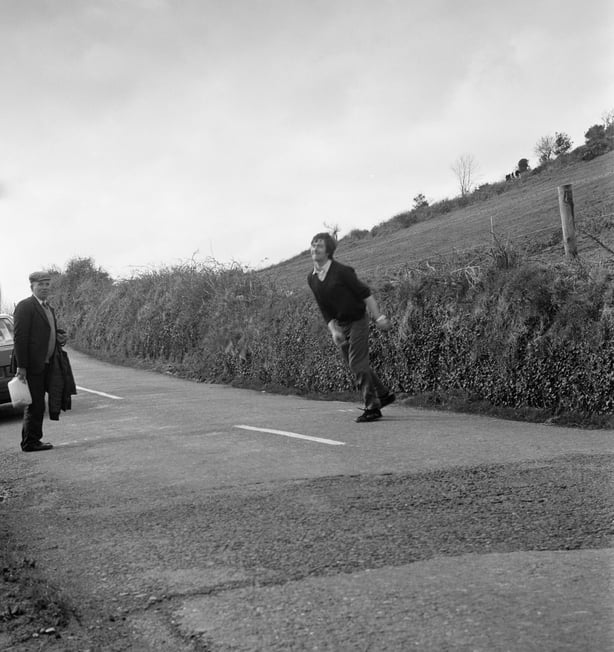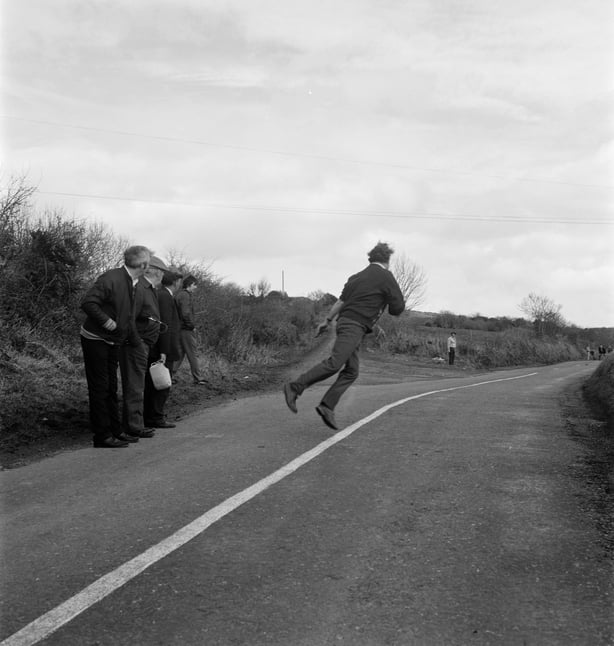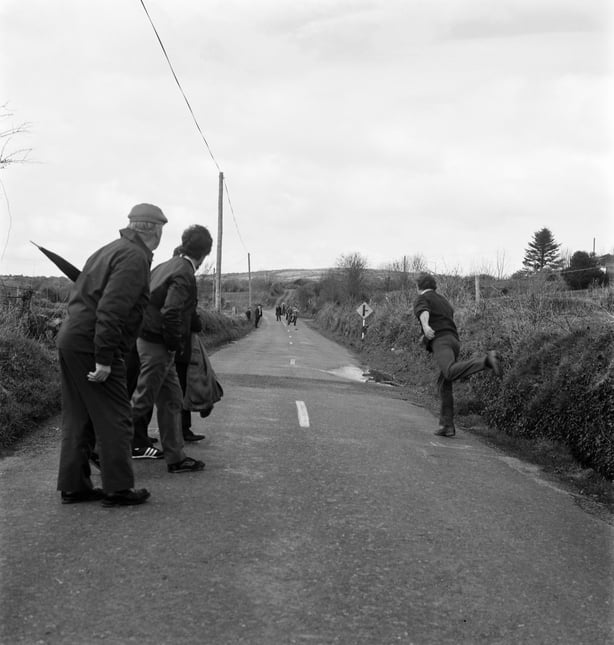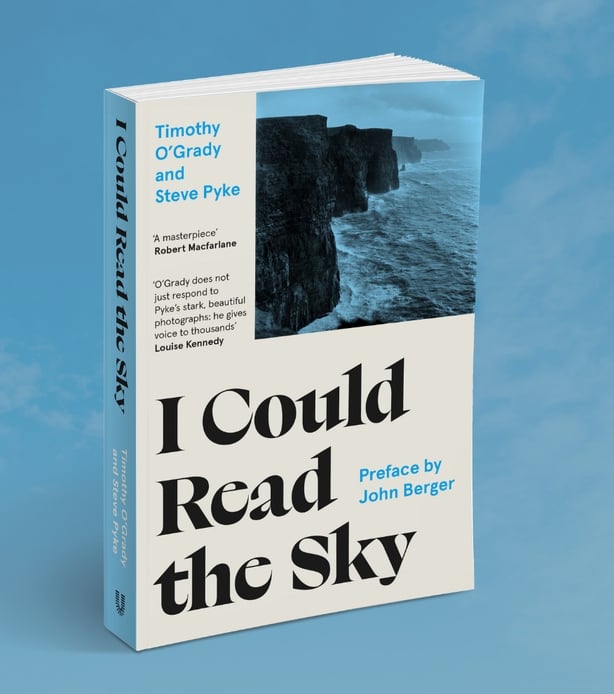Timothy O'Grady and Steve Pyke’s I Could Read the Sky, a novel made of pictures and words, has been acclaimed as a classic since it first appeared twenty-six years ago.
Redesigned by its authors and containing new, never-before-seen photographs, it has just been reissued by Unbound.
Below, Timothy O’Grady writes about one of the book’s memorable photographs.
In the photograph a man is in the air. He has diamond patterns on his jumper and a murderous look on his face. He is on a country road. Three men are with him, one carrying an umbrella, another a plastic container that might be meant for petrol, both in flat caps, but these two are not looking at him. They are looking ahead along the road. Only a younger man in white trainers and with his hands in his pockets looks at the man who has taken to the air above a chalk line and letters on the road in a posture that might have been choreographed by Balanchine. Who is this man and what is he doing? The photograph doesn’t say. It seems to have no past or future.
We need your consent to load this rte-player contentWe use rte-player to manage extra content that can set cookies on your device and collect data about your activity. Please review their details and accept them to load the content.Manage Preferences
Listen: I Could Read The Sky celebrated on RTÉ Arena
I first saw the photograph in Steve Pyke's kitchen. We had been asked by a publisher to collaborate on a book based on photographs he’d been taking in Ireland over the previous decade. Photographers and writers may be well met but their work together on a page rarely evolves into a marriage of equals. One dominates. The other serves. Or they maintain an awkward silence with regard to one another. The photographs illustrate or decorate the text. Or the text explains the photograph, like a card with small type beside a picture in a museum.
Steve Pyke and I wanted to make a book where the photographs and the words do what only they can do but come together in a single act of storytelling. John Berger was a guide. No one, including me, expected it to become a novel. In I Could Read the Sky the pictures and the words are in the mind of an old Irish migrant labourer, alone and sleepless in a room in London, as he sees again the losses and the high, exalted moments of his life.

Novels tend to have a lot of furniture – rooms, cities, family structures, conflicts,, intricate plots, explanations of behavior. Photographs are singular, immediate and, if they are like this one, inexplicable. When there are people in them they are, according to Steve Pyke, about the drama of gesture. They form a kind of spontaneous, uncontrived photographic speech. This is what he’s always looking for when he chooses the picture he wants to put forward. Writing in the face of photographs I found I could dispense with much of the furniture that normally appears in novels.

Many people in Ireland looking at this photograph will know, unlike me, that the man in the air is "throwing the bullet". Road bowling may have come to Ireland in the seventeenth century with Dutch troops loyal to William of Orange, or maybe with Spaniards washed ashore from the vanquished Armada. They threw small cannonballs. It is played now only in Armagh and Cork. Each has its own form of violent toss. Competitors strive to advance the ball from one village to the next in the least amount of throws. But does knowing this enhance the impact of the photograph? Steve Pyke and I thought not. If you don’t know what these men are doing you see human worry, curiosity and intense effort in naked form, without the clothing of context. This is why the photographs have no captions.

Steve Pyke came upon this scene in 1987 in West Cork. He only had four frames of film left in his Rolleiflex. Above are the other three frames he shot that day.
The attending men are officiating or laying bets or cheering on. They look serious, but it’s a festive day. The plastic container in the first photograph has poitίn in it. The picture is beside me on the wall where I write this in the Vistula Valley in Poland.

Read an excerpt from I Could Read the Sky:
What I could do.
I could mend nets. Thatch a roof. Build stairs. Make a basket from reeds. Splint the leg of a cow. Cut turf. Build a wall. Go three rounds with Joe in the ring Da put up in the barn. I could dance sets. Read the sky. Make a barrel for mackerel. Mend roads. Make a boat. Stuff a saddle. Put a wheel on a cart. Strike a deal. Make a field. Work the swarth turner, the float and the thresher. I could read the sea. Shoot straight. Make a shoe. Shear sheep.
Remember poems. Set potatoes. Plough and harrow. Read the wind. Tend bees. Bind wyndes. Make a coffin. Take a drink. I could frighten you with stories. I knew the song to sing to a cow when milking. I could play twenty-seven tunes on my accordion.
I Could Read the Sky is available from booksellers or directly from the publishers here - an audiobook read by Timothy O’Grady and with music by fiddler Martin Hayes can also be purchased there or from usual outlets.

